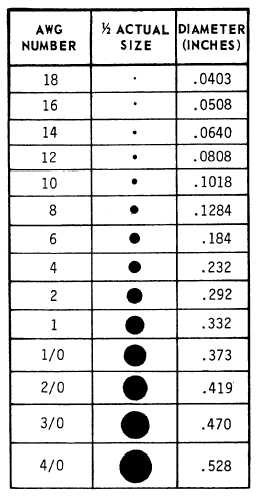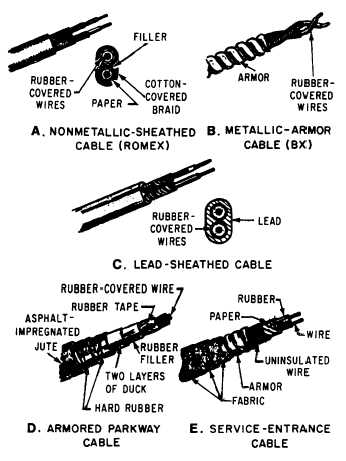chances for short circuits and to protect
personnel. Atmospheric conditions, voltage
requirements, and environmental and operating
temperatures are factors to consider in selecting
the type of insulating material for a particular job.
SINGLE CONDUCTORS.— A single con-
ductor may consist of one solid wire or a number
of stranded, uncovered, solid wires that share in
carrying the total current. A stranded conductor
has the advantage of being more flexible than
a solid conductor, making it more adaptable
for pulling through any bends in a conduit.
Common types of single conductors are shown
in figure 9-12.
Conductors vary in diameter. Wire manufac-
turers have established a numerical system,
called the American Wire Gage (AWG) Standard,
to eliminate the necessity for cumbersome circular
mil or fractional-inch diameters in describing wire
Figure 9-13.—Comparison of standard wire gauge number
to wire diameters.
sizes. Figure 9-13 shows a comparison of one-half
actual wire diameters to their AWG numerical
designations. Notice that the wire gauge number
increases as the diameter of the wire decreases.
The wire size most frequently used for interior
wiring is No. 12 AWG and is a solid conductor.
No. 8 and larger wires are normally used for heavy
power circuits or as service entrance leads to
buildings.
The type of wire used to conduct current from
outlet boxes to sockets in the lighting fixtures is
called “fixture wire.” It is stranded for
flexibility and is usually size 16 or 18 AWG.
MULTIWIRE (CABLE) CONDUCTORS.—
A multiwire conductor, called a CABLE, is an
assembly of two or more conductors insulated
from each other with additional insulation or a
protective shield formed or wound around the
group of conductors. The covering or insulation
for individual wires is color coded for proper
identification. Figure 9-14 shows common types
of multiwire conductors.
Figure 9-14.—Types of multiwire insulated conductors
(cables).
9-9




